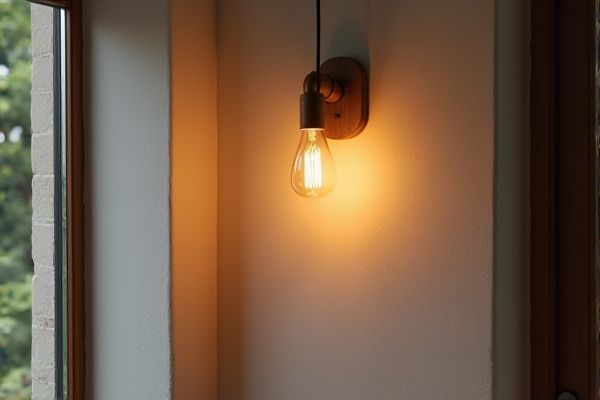
Sconces provide wall-mounted lighting that offers subtle illumination and space-saving benefits, while pendants hang from the ceiling and serve as focal lighting fixtures with adjustable height and style. Explore the rest of this article to discover which lighting option best suits your space and design needs.
Table of Comparison
| Feature | Sconce | Pendant |
|---|---|---|
| Mounting Location | Wall-mounted | Ceiling-mounted |
| Lighting Direction | Ambient, accent, or task lighting | Focused task or ambient lighting |
| Space Usage | Saves floor space, ideal for hallways and bathrooms | Requires ceiling clearance, suits dining and kitchen areas |
| Design Style | Traditional to modern, decorative wall fixtures | Contemporary to industrial, hanging fixtures |
| Installation Complexity | Moderate, mounted on existing walls | Variable, may require ceiling reinforcement and wiring |
| Light Coverage | Wider area with indirect lighting | More focused and direct illumination |
| Common Uses | Hallways, bedrooms, bathrooms, accent lighting | Dining rooms, kitchens, entryways, task-focused areas |
Introduction to Sconces and Pendants
Sconces and pendants are popular lighting fixtures that serve distinct purposes in interior design, with sconces typically mounted on walls to provide ambient or accent lighting, while pendants hang from the ceiling, offering focused illumination for tasks or style statements. Sconces save floor space and add architectural interest, ideal for hallways or accent walls, whereas pendants create focal points over dining tables, kitchen islands, or seating areas, enhancing the room's atmosphere. Your choice between a sconce and a pendant depends on the lighting needs, layout, and aesthetic goals of your space.
What Is a Sconce?
A sconce is a wall-mounted light fixture designed to illuminate spaces without occupying floor or table surfaces, making it ideal for narrow or confined areas. Typically positioned at eye level or higher, sconces provide ambient, accent, or task lighting while enhancing interior decor with their varied designs. Unlike pendant lights, which hang from the ceiling, sconces offer directional lighting that emphasizes walls or architectural features.
What Is a Pendant Light?
A pendant light is a fixture that hangs from the ceiling, typically suspended by a cord, chain, or metal rod, providing focused illumination over areas like kitchen islands, dining tables, or entryways. Its design directs light downward, making it ideal for task lighting and adding a decorative accent to your space. Unlike sconces, which are wall-mounted, pendant lights offer versatile styles and adjustable heights to suit various interior aesthetics and functional needs.
Key Differences: Sconce vs Pendant
Sconces are wall-mounted lighting fixtures designed to provide ambient or accent lighting, while pendants hang from the ceiling and often serve as task or decorative lighting. Sconces typically create a softer, indirect light and save floor or table space, whereas pendants offer focused illumination directly below the fixture, ideal for dining areas or workspaces. Your choice depends on the desired light direction, space constraints, and the room's overall aesthetic.
Design and Aesthetic Appeal
Sconces provide a subtle, wall-mounted lighting solution that enhances room ambiance with soft, diffused light, ideal for creating cozy or decorative focal points. Pendants offer a bold design statement, hanging from the ceiling to illuminate specific areas while adding visual interest with various shapes, materials, and sizes. Your choice between the two depends on whether you want understated elegance or a striking centerpiece to elevate your space's aesthetic appeal.
Lighting Functionality and Ambience
Sconces provide focused, ambient lighting ideal for accentuating architectural features or creating a cozy atmosphere with soft, diffused light. Pendants offer versatile lighting functionality, delivering direct illumination suitable for task areas like kitchen islands or dining tables while contributing to overall room ambience. Both fixtures enhance spatial aesthetics but differ in light distribution and intensity, with sconces favoring subtle ambiance and pendants emphasizing brighter, task-oriented lighting.
Space and Placement Considerations
Sconces are ideal for narrow hallways or tight spaces where wall-mounted lighting provides ambient or accent illumination without occupying floor space. Pendants require sufficient ceiling height and open area to hang freely without obstructing movement, making them suitable for dining rooms or kitchens over countertops. Selecting between sconces and pendants depends on spatial dimensions and functional placement to optimize lighting aesthetics and efficiency.
Installation and Maintenance
Sconces typically require wall mounting, often making installation straightforward with minimal electrical wiring adjustments, while pendants hang from the ceiling, demanding careful suspension and proper ceiling electrical box support. Maintenance for sconces involves occasional dusting and bulb replacement, often easier to access due to their wall position, whereas pendants may need more effort to clean and replace bulbs given their height and hanging setup. Choosing between these lighting fixtures depends on your space's layout and how accessible you want maintenance tasks to be.
Cost and Energy Efficiency
Sconces generally cost less upfront than pendant lights due to simpler designs and smaller materials, making them a budget-friendly option. Energy efficiency depends largely on the bulb type; both sconces and pendants can use LED bulbs, significantly reducing energy consumption compared to traditional incandescent bulbs. Pendant lights may require higher wattage for larger spaces, potentially increasing electricity costs, while sconces provide localized lighting with lower energy use.
Choosing Between Sconce and Pendant for Your Space
Choosing between a sconce and a pendant depends on your space's lighting needs and design goals. Sconces provide subtle, wall-mounted illumination ideal for hallways or accent lighting, while pendants offer focused, downward light perfect for dining areas or kitchen islands. Your choice should reflect the ambiance you want to create and the functional requirements of each room.
 homyna.com
homyna.com